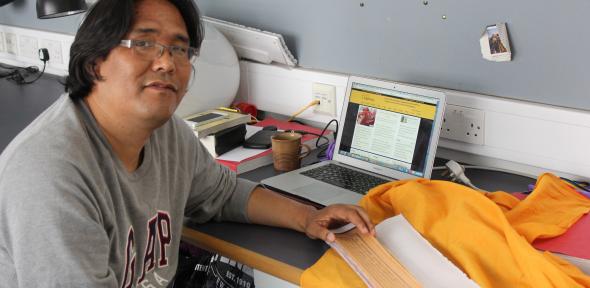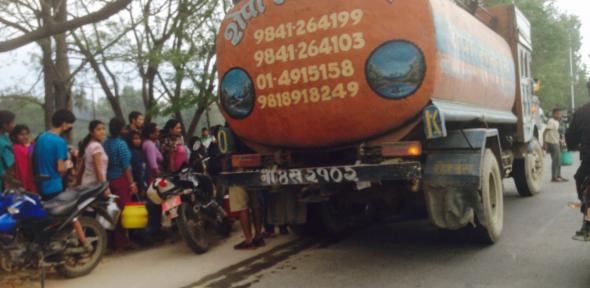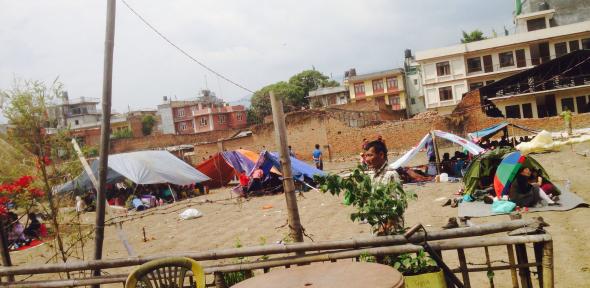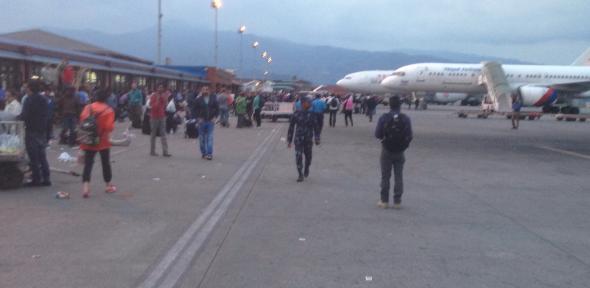
Much will need to be done to rebuild Nepal and the focus now must be the international aid effort. To donate go to: www.dec.org.uk/appeals/nepal-earthquake-appeal.
Much will need to be done to rebuild Nepal and the focus now must be the international aid effort. To donate go to: www.dec.org.uk/appeals/nepal-earthquake-appeal.
I hope we can help get the Nepalese and the Tibetans... food, water and whatever they need as soon as possible.
Dr Lobsang Yongdan
When the first earthquake struck Kathmandu close to midday on April 25 Dr Lobsang Yongdan was in a small hotel getting ready to head out into the city and find some food.
A scholar working on Tibetan historical texts Yongdan had been in Tibet visiting relatives following the successful completion of his PhD in the Department of Social Anthropology.
Following his visit to relatives Yongdan had then travelled from Lhasa to Nepal’s capital by road on his way back to the UK because he wanted to see the Nepalese countryside up close and knew Kathmandu was a good place to buy classical texts and dictionaries.
Sitting in the safety of the Mongolian and Inner Asian Studies Unit’s (MIASU) Mond Building in Cambridge just a few days after leaving the capital he says: “The Nepalese will need our help. I saw villages on hillsides during my 24 hour car journey to Kathmandu. I do not know what condition they are in now. The villages are remote and in the mountains so I can imagine the landslides affecting whole villages and wiping out the roads.”
Yongdan's scholarship reflects the strong links between the University of Cambridge, Nepal and Tibet. They encompass many disciplines including archaeology, biological and social anthropology (for example the Digital Himalaya project and the work of the MIASU). University students have also volunteered as English language teachers in rural Nepal through charities. Some of those students have undertaken their own fundraising following the disaster.
Arriving in Kathmandu Yongdan had bought a Tibetan-English dictionary and a few classical texts and was ready to “do the tourist thing”, taking in some of the city’s famous sites such as the Boudhanath, a place of great significance to Buddhists and a UNESCO World Heritage Site.
Such sites reflect the connections between Nepal and Tibet, says Yongdan: “The links between Nepal and Tibet are strong. Many craftsman who helped build the Tibetan temples and monasteries came from Nepal.”
But as he prepared to take in the sights the earthquake struck.
“When the earthquake came I was lucky as I was on the ground floor of my hotel so it was easy to run outside. But there were many large flower pots on the balconies of the surrounding building which were all falling down. I was very lucky not to be hit as these pots were falling from the fifth and sixth floors. A large one just missed me by a few centimetres,” says Yongdan.
By this time many other guests were flooding from the building into the courtyard. “Many were crying. There was shock and a lot of distress. The first earthquake was over in just one minute I think – but there were many aftershocks.”
It is those aftershocks which took a huge psychological toll, says Yongdan, adding: “Everyone reacted very strongly to the aftershocks. The first, big quake, was all about fast reactions, but the later shocks created much more fear and anxiety. Even a heavy footfall, or airplane flying overhead, would cause feelings of panic. I was there for just two days; those still out there, feeling aftershocks over a longer period, will have suffered much more and the trauma could be very great.”
Yongdan remained in the courtyard for some time, eyeing the cracks in the building warily, conscious that they had no food or water. Knowing he was due to fly from the capital that very day Yongdan risked entering the hotel to retrieve his wallet and passport. Eventually he was able to walk into the city and buy some water and a biscuit. It was then he got his first glimpse of the powerful and tragic effects of the earthquake. “There was a wall, about 10 feet high, which traders used to do their business from. It had collapsed and it was here I saw the first people who had died.”
Back at the hotel Yongdan and his group moved to an open field nearby and spent a fearful night as the aftershocks continued.
“During the night we had two big aftershocks at about 4am and 6am, I think. We could not sleep as all night we could see the buildings shaking. Sometimes the shocks came like a wave, sometimes quickly like a train going along the tracks.”
Yongdan realised that food and water would be a huge problem and that should take his flight, if possible. The next day Yongdan, accompanied by an US woman in her 60s, went looking for a car to take them to the airport. “It would be a long way to walk. People were in the centre of the road, staying away from the buildings, finding a car seemed impossible. To our surprise we eventually saw one single taxi driving around. He charged us fifteen times the normal price but we got to the airport,” says Yongdan.
On the way to the airport the full extent of the devastation hit Yongdan. Buildings had collapsed or were heavily damaged. “When we got to the airport there was a truck which was delivering water to people who had gathered in a nearby field - but there were thousands of people in the field and a long queue.”
“The airport was crowded and everything was being done manually. Only those who had tickets were being allowed to fly at this stage. People were shouting. We stood in line for three hours waiting to hear if we would fly out or not. Once through we were in an open field and I felt much safer. We waited almost five hours and saw the Indian Air Force flying in with supplies.”
It was only when Yongdan was in the air that he relaxed enough to sense how lucky he was – and only once in Abu Dhabi that he felt anything close to the full impact. “I suddenly realised what I had been through and that I had nearly died. I called my family. I have never heard my father cry before but both of them were very emotional.”
It was at Abu Dhabi that the news of his having reached safety finally reached colleagues in Cambridge.
Dr Hildegard Diemberger, Director of MIASU, says: “I was hugely relieved when I was woken up at 1am by a text message from New York telling me they had heard Yongdan was safe. When he arrived at Pembroke his luggage had been left somewhere between Kathmandu and Abu Dhabi and he just had the clothes he was standing in.”
Safe in Cambridge, staying in a student room at Pembroke College, Yongdan says his thoughts are with those left behind. “I had to leave,” he says, “I thought whether I could help there and then but without knowing much about the place and the people I would have been another burden. I thought that mobilising competent international help would have been more useful and I hope we can help get the Nepalese and the Tibetans affected by the earthquake food, water and whatever they need as soon as possible. We keep hearing heart-breaking messages of people, including young children, now exposed to rain, lacking water, food and trying to cope with loss and fear”
The problem will not just be food and water, says Diemberger: “Sewage will now be an issue as will disease. The way some buildings are constructed means the earthquake has had a devastating effect.”
Once the initial battle for survival is over and food and water supplies have been secured other priorities will surface.
“We must look to the international relief effort first and then in the long term we can look to charities and action to support communities and help rebuild and ensure the rich heritage of Nepal is protected. But first they will have to get through the monsoon season. It will be a difficult process. Once the reconstruction process is underway there will be an enormous amount to do. Many of the sites affected are UNESCO World Heritage Sites so the hope is they will not be rebuilt too quickly and destroy what little is left. I am also thinking about the multitude of temples and monasteries scattered across the region. They house precious ancient manuscripts and prints, which are likely to have become exposed to the rain and are at risk of being lost forever” says Diemberger.
More information:
- For more information on the Nepal relief effort and how to offer support go to: www.dec.org.uk/appeals/nepal-earthquake-appeal.
- Yongdan is a scholar who straddles the ancient and modern worlds. Initially educated in the Buddhist monastery of Kumbum (Qinghai Province, PRC), he possesses a rare talent for languages being fluent in Classical Tibetan, the Tibetan dialect of Amdo, Chinese and English. His PhD at Cambridge was on a remarkable Tibetan text, the Dzam gling rgyas bshad (DGRB), which translates as The Detailed Description of the World. He is currently working on an AHRC project hosted at MIASU to create a database of the earliest printed texts in Tibetan culture and the biographies of the Tibetan masters involved in the production of woodblock prints since the 12th century.

The text in this work is licensed under a Creative Commons Attribution 4.0 International License. For image use please see separate credits above.





